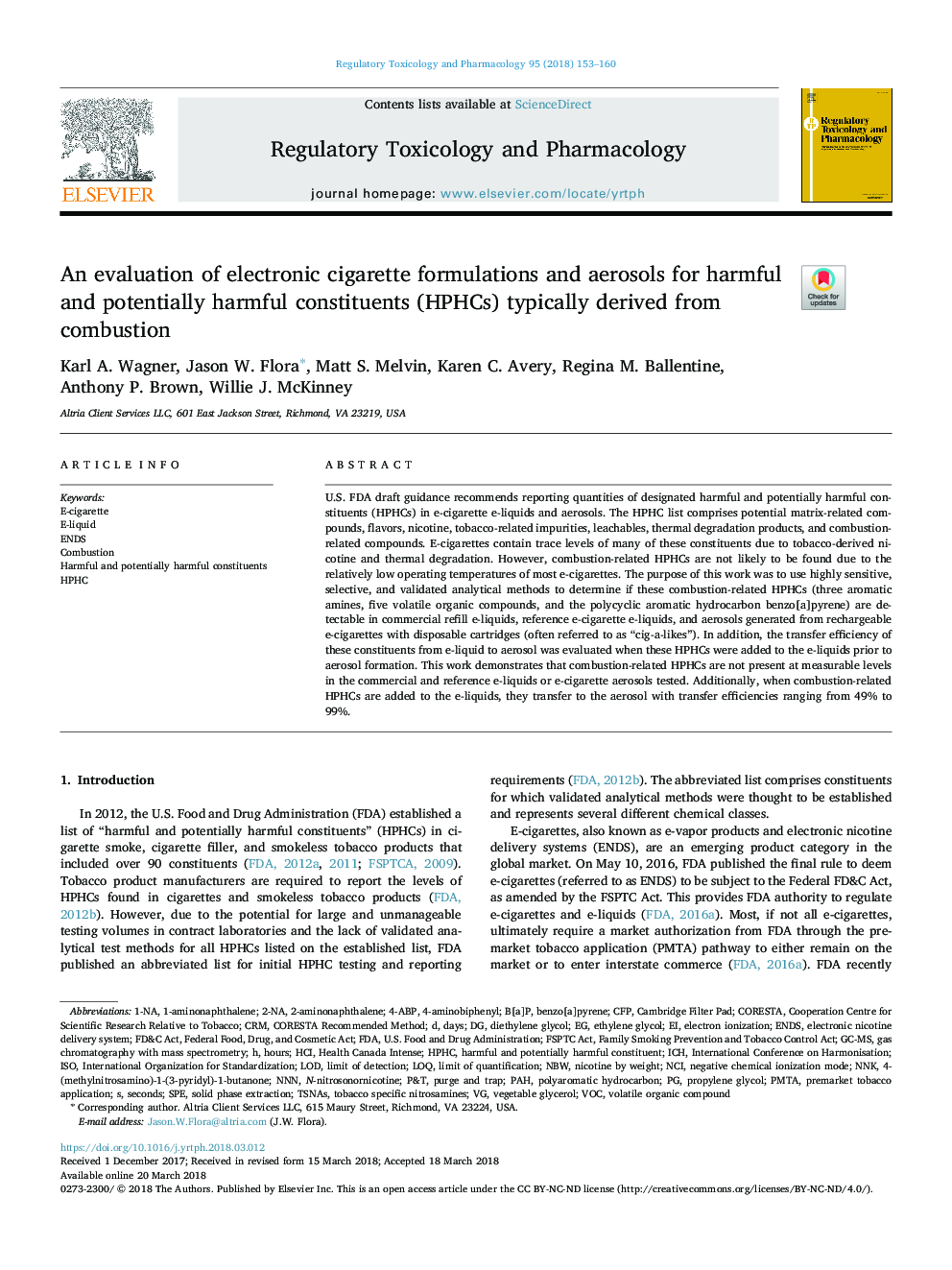| کد مقاله | کد نشریه | سال انتشار | مقاله انگلیسی | نسخه تمام متن |
|---|---|---|---|---|
| 8551324 | 1562107 | 2018 | 8 صفحه PDF | دانلود رایگان |
عنوان انگلیسی مقاله ISI
An evaluation of electronic cigarette formulations and aerosols for harmful and potentially harmful constituents (HPHCs) typically derived from combustion
دانلود مقاله + سفارش ترجمه
دانلود مقاله ISI انگلیسی
رایگان برای ایرانیان
کلمات کلیدی
TSNAsNNKNBWP&TENDSNNNN-nitrosonornicotine2-NAe-liquidCRMCFPHCIFDASPEHPHCCambridge filter padVOCNCILOQPAH4-ABPGC-MS - کروماتوگرافی گازی-طیف سنج جرمی4-(methylnitrosamino)-1-(3-pyridyl)-1-butanone - 4- (methylnitrosamino) -1- (3-pyridyl) -1-butanone4-aminobiphenyl - 4-آمینوبیفنیلB[a]P - B [a] PEthylene glycol - اتیلن گلیکولCombustion - احتراقU.S. Food and Drug Administration - اداره غذا و داروی ایالات متحدهSolid phase extraction - استخراج فاز جامدISO - ایزوBenzo[a]pyrene - بنزو [a] پییرنHealth Canada Intense - بهداشت کانادا شدیدVolatile organic compound - ترکیب آلی فرارPurge and trap - تمیز کردن و تلهTobacco specific nitrosamines - تنباکو ویژه نیتروستامینیseconds - ثانیهLOD یا Limit of detection - حد تشخیصdiethylene glycol - دیتیلن گلیکولdays - روزهاInternational Organization for Standardization - سازمان بین المللی استاندارد سازیhours - ساعت هاElectronic nicotine delivery system - سیستم تحویل نیکوتین الکترونیکیE-cigarette - سیگار الکترونیکیFederal Food, Drug, and Cosmetic Act - قانون غذا، دارو و لوازم آرایشی فدرالlimit of quantification - محدودیت اندازه گیریlimit of detection - محدودیت تشخیصCooperation Centre for Scientific Research Relative to Tobacco - مرکز همکاری تحقیقات علمی مربوط به دخانیاتICH - منharmful and potentially harmful constituents - مواد مضر و بالقوه مضرHarmful and potentially harmful constituent - مواد مضر و مضرPolyaromatic hydrocarbon - هیدروکربن PolyaromaticPropylene glycol - پروپیلن گلیکولgas chromatography with mass spectrometry - کروماتوگرافی گاز با طیف سنج جرمیInternational Conference on Harmonisation - کنفرانس بین المللی هماهنگیCORESTA - کورستاelectron ionization - یونیزاسیون الکترون
موضوعات مرتبط
علوم زیستی و بیوفناوری
علوم محیط زیست
بهداشت، سم شناسی و جهش زایی
پیش نمایش صفحه اول مقاله

چکیده انگلیسی
U.S. FDA draft guidance recommends reporting quantities of designated harmful and potentially harmful constituents (HPHCs) in e-cigarette e-liquids and aerosols. The HPHC list comprises potential matrix-related compounds, flavors, nicotine, tobacco-related impurities, leachables, thermal degradation products, and combustion-related compounds. E-cigarettes contain trace levels of many of these constituents due to tobacco-derived nicotine and thermal degradation. However, combustion-related HPHCs are not likely to be found due to the relatively low operating temperatures of most e-cigarettes. The purpose of this work was to use highly sensitive, selective, and validated analytical methods to determine if these combustion-related HPHCs (three aromatic amines, five volatile organic compounds, and the polycyclic aromatic hydrocarbon benzo[a]pyrene) are detectable in commercial refill e-liquids, reference e-cigarette e-liquids, and aerosols generated from rechargeable e-cigarettes with disposable cartridges (often referred to as “cig-a-likes”). In addition, the transfer efficiency of these constituents from e-liquid to aerosol was evaluated when these HPHCs were added to the e-liquids prior to aerosol formation. This work demonstrates that combustion-related HPHCs are not present at measurable levels in the commercial and reference e-liquids or e-cigarette aerosols tested. Additionally, when combustion-related HPHCs are added to the e-liquids, they transfer to the aerosol with transfer efficiencies ranging from 49% to 99%.
ناشر
Database: Elsevier - ScienceDirect (ساینس دایرکت)
Journal: Regulatory Toxicology and Pharmacology - Volume 95, June 2018, Pages 153-160
Journal: Regulatory Toxicology and Pharmacology - Volume 95, June 2018, Pages 153-160
نویسندگان
Karl A. Wagner, Jason W. Flora, Matt S. Melvin, Karen C. Avery, Regina M. Ballentine, Anthony P. Brown, Willie J. McKinney,